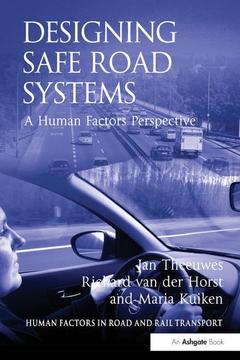Designing Safe Road Systems A Human Factors Perspective Human Factors in Road and Rail Transport Series
Auteurs : Theeuwes Jan, Horst Richard van der

Date de parution : 07-2012
15.6x23.4 cm
Date de parution : 03-2017
15.6x23.4 cm
Thèmes de Designing Safe Road Systems :
Mots-clés :
Automatic Incident Detection; users; Road User; Maria Kuiken; VMS; Michel Lambers; Driving Task; Richard van der Horst; Road System Design; Risk Homeostasis Theory; In-car Navigation System; Individual Information Elements; Railway Level Crossings; Lane Choice; SERs; Basic Ergonomic Principles; Road User Behaviour; Road Category; Dutch Motorway; Novice Drivers; Motorway Engineer; Behaviour Adaptation; Exit Lane; Driving Behaviour Model; Risk Compensation; Swat; Inexperienced Drivers; Latent Errors; Forward Roadway



